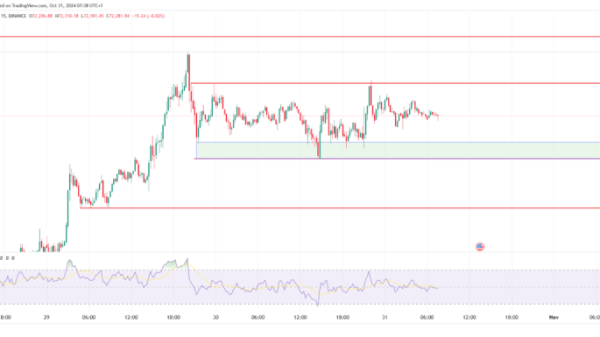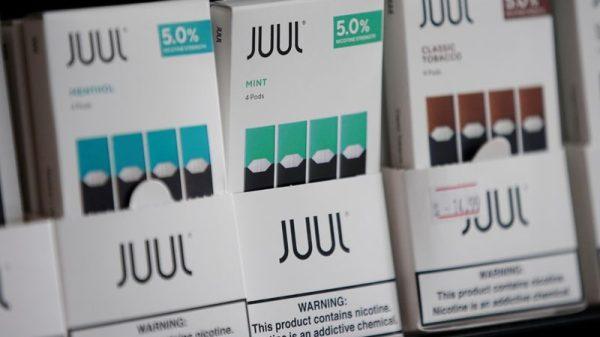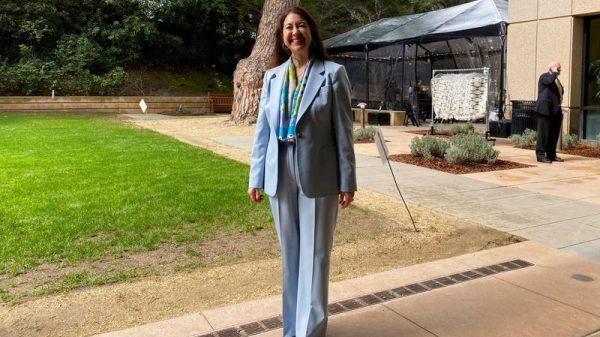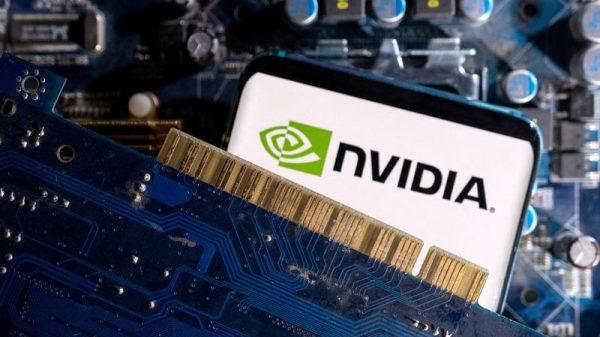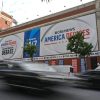In the recently held Third Quarter 2024 Earnings Call, ASE Technology Holdings (ASX) outlined a period of growth and strategic expansion. Ken Hsiang, Head of Investor Relations, announced a fully diluted earnings per share (EPS) of TWD2.17, with consolidated net revenues showing a 14% sequential increase and a 4% rise year-over-year to TWD164.4 billion.
The company also highlighted plans for significant capital expenditures in advanced packaging technologies, expecting to exceed TWD1.9 billion annually, and projected a strong demand for leading-edge products.
Key Takeaways
ASE Technology Holdings reported a fully diluted EPS of TWD2.17 for Q3 2024.
Consolidated net revenues increased to TWD164.4 billion, with a 14% sequential and 4% year-over-year growth.
Gross profit reached TWD26.4 billion, and the gross margin was at 16.5%.
The company plans to significantly increase capital expenditures for advanced packaging.
Strong demand is expected for leading-edge products, while the outlook for EMS is weaker.
ASE anticipates cost pressures from typhoon impacts, increased utility rates, and a stronger NT dollar.
Company Outlook
ASE expects to maintain a Q&A format in earnings calls, allowing two questions per participant.
The company forecasts robust demand for AI and high-performance computing products.
ASE aims for aggressive capacity expansion in leading-edge and testing capabilities, targeting strong results in 2025.
Bearish Highlights
EMS revenue showed a TWD0.3 billion annual decrease.
Margins may be affected by cost pressures such as typhoon impacts, increased utility rates, and a stronger NT dollar.
The first half of 2024 might experience weaker margins due to front-end loaded investments.
Bullish Highlights
ATM business revenues increased both sequentially and annually, with a gross margin of 23.1%.
The company is collaborating with foundry partners to expand capacity, focusing on immediate customer needs.
Gross margins are projected to improve as leading-edge solutions become a larger part of the revenue mix.
Misses
Gross margins in the current year underperformed due to weak market conditions and reliance on leading-edge technology, which is still a small revenue segment.
Q&A Highlights
Executives emphasized collaboration with foundry partners to address growing demand.
Investments across various processes, including chip-on-wafer and substrate assembly, are planned.
Advanced testing is expected to increase its share in the revenue mix next year.
ASE Technology Holdings’ Third Quarter 2024 Earnings Call highlighted the company’s financial health and strategic initiatives. With increased revenues and a strong focus on advanced packaging and testing capabilities, ASE is positioning itself for sustained growth despite facing some cost pressures and market challenges. The company’s executives remain optimistic about the future, particularly with the anticipated recovery of the semiconductor market and the expansion of leading-edge technology offerings.
InvestingPro Insights
ASE Technology Holdings’ (ASX) recent earnings call aligns with several key metrics and insights from InvestingPro. The company’s focus on growth and strategic expansion is reflected in its market performance and financial indicators.
According to InvestingPro data, ASX boasts a market capitalization of $21.32 billion USD, underlining its significant presence in the Semiconductors & Semiconductor Equipment industry. This aligns with the company’s reported revenue growth and planned capital expenditures in advanced packaging technologies.
The company’s P/E ratio of 21.39 suggests that investors are willing to pay a premium for ASX’s earnings, possibly due to its growth prospects in leading-edge products and AI-related demand, as mentioned in the earnings call. This is further supported by an InvestingPro Tip indicating that ASX has been profitable over the last twelve months, with analysts predicting continued profitability this year.
ASX’s commitment to shareholder value is evident from two InvestingPro Tips: the company has raised its dividend for 3 consecutive years and has maintained dividend payments for 7 consecutive years. This is particularly noteworthy given the company’s plans for significant capital expenditures, demonstrating a balance between reinvestment and shareholder returns.
The revenue for the last twelve months stands at $18,072.47 million USD, with a modest quarterly revenue growth of 2.91% in Q2 2024. While this growth is not as robust as the 14% sequential increase reported in the earnings call, it still indicates positive momentum.
For investors seeking more comprehensive analysis, InvestingPro offers additional tips and insights. Currently, there are 6 more InvestingPro Tips available for ASX, providing a deeper understanding of the company’s financial health and market position.
Full transcript – ASE Industrial Holding Co Ltd ADR (ASX) Q3 2024:
Ken Hsiang: Hello. I am Ken Hsiang, the Head of Investor Relations for ASE Technology Holdings. Welcome to our Third Quarter 2024 Earnings Release. Thank you for attending our second consecutive Typhoon holiday earnings release. Please refer to our Safe Harbor notice on Page 2. All participants consent to having their voices and questions broadcast via participation in this event. If participants do not consent, please disconnect at this time. I would like to remind everyone that the presentation that follows may contain forward-looking statements. These forward-looking statements are subject to a high degree of risk, and our actual results may differ materially. For the purposes of this presentation, dollar figures are generally stated in New Taiwan unless otherwise indicated. As a Taiwan-based company, our financial information is presented in accordance with Taiwan IFRS. Results presented using Taiwan IFRS may differ materially from results using other accounting standards, including those presented by our subsidiary using Chinese GAAP. I’m joined today by Joseph Tung, our CFO. For today’s presentation, I will be going over the financial results and company outlook. Joseph will then be available to take your questions during the Q&A session that follows. We are altering our Q&A format slightly. During the Q&A session, I will be moderating, receiving and clarifying each question and repeating your questions to Joseph. With that, let’s get started. The third quarter ATM seasonality came in slightly better than originally anticipated. The pickups were mostly driven by strength in leading-edge advanced packaging and the seasonal ramps of some communications devices. Our overall equipment utilization was between 65% to 70%. For our EMS business, in the third quarter, demand for our services was also slightly ahead of our initial expectations. However, the higher demand was most likely attributable to an earlier seasonality. Please turn to Page 3, where you will find our third quarter consolidated results. For the third quarter, we recorded fully diluted EPS of TWD2.17 and basic EPS of TWD2.24. Consolidated net revenues increased 14% sequentially and 4% year-over-year. We had a gross profit of TWD26.4 billion with a gross margin of 16.5%. Our gross margin improved by 0.1 percentage points sequentially and 0.3 percentage points year-over-year. The sequential improvement in margin is principally due to improved operating leverage offset by higher EMS product mix. Our operating expenses increased by TWD0.9 billion sequentially, and by TWD1.4 billion annually. The sequential increase in operating expenses are primarily due to higher labor, bonus-related expenses and other administrative expenses. The year-over-year increase in operating expenses is primarily attributable to continued R&D staff-up and other labor-related costs. Our operating expense percentage came down by 0.7 percentage points to 9.3% sequentially and increased by 0.5 percentage points year-over-year. The sequential decline in operating expenses is attributable to higher operating leverage due to higher loading levels. The annual increase was also related to higher R&D staff-up for both ATM and EMS. Overseas expansion and higher incentive stock options and bonus expenses. Operating profit was TWD11.5 billion, up TWD2.5 billion sequentially and TWD0.1 billion year-over-year. Operating margin increased 0.8 percentage points sequentially and declined 0.2 percentage points year-over-year. During the quarter, we had a net non-operating gain of TWD0.8 billion. Our non-operating gain for the quarter primarily consists of net foreign exchange hedging activities, profits from associates and other non-operating income, offset in part by net interest expense of TWD1.3 billion. Tax expense for the quarter was TWD2.1 billion, our effective tax rate for the quarter was 16%. The effective tax rate during the quarter was lower primarily because of tax impacts of foreign currency fluctuations. We continue to expect an ongoing annual effective tax rate of approximately 20.5%. Net income for the quarter was TWD9.7 billion, representing an increase of TWD1.9 billion sequentially and TWD0.9 billion year-over-year. The NT dollar was relatively steady during the third quarter, depreciating 0.3% against the U.S. dollar sequentially, while depreciating 2.7% annually. From a sequential perspective, we estimate the NT dollar depreciation on less than a 0.1 percentage point positive impact to the company’s gross and operating margins. While from an annual perspective, we estimate the NT dollar depreciation had a 0.7 percentage point positive impact to the company’s gross and operating margins. On the bottom of the page, we provide key P&L line items without the inclusion of PPA-related expenses. Consolidated gross profit, excluding PPA expenses, would be TWD27.4 billion, with 17.1% gross margin. Operating profit would be TWD12.7 billion with an operating margin of 7.9%. Net profit would be TWD10.8 billion with a net margin of 6.8%. Basic EPS, excluding PPA expenses, would be TWD2.51. On Page 4 is a graphical presentation of our consolidated financial performance. Since the start of 2023, you will see here a trough-ish but gradually improving environment for both our ATM and EMS businesses. On a year-over-year basis, gross margins have been gradually improving. On the operating margin front, as was stated earlier, operating expenses are increasing for expected ramps in leading-edge advanced packaging products and, to a lesser extent, offshore site expansion costs from our EMS businesses. On Page 5 is our ATM P&L. The ATM revenue reported here contains revenues eliminated at the holding company level related to intercompany transactions between our ATM and EMS businesses. For the third quarter of 2024, revenues for our ATM business were TWD85.8 billion, up TWD8 billion from the previous quarter and up TWD2.1 billion from the same period last year. This represents a 10% increase sequentially and a 3% increase annually. Gross profit for our ATM business was TWD19.8 billion, up TWD2.6 billion sequentially and up TWD1.2 billion year-over-year. Gross profit margin for our ATM business was 23.1%, up 1 percentage point sequentially and up 0.9 percentage points year-over-year. The sequential margin improvement was primarily related to higher equipment utilization, offset in part by higher raw material product mix and higher utility costs. We expect the higher raw material product mix environment to extend into the fourth quarter. The annual margin improvement is primarily the result of favorable foreign exchange and product mix. During the third quarter, operating expenses were TWD10.6 billion, up TWD0.6 billion sequentially, and TWD0.8 billion year-over-year. The sequential increase in operating expenses was primarily driven by higher labor-related expenses much of which is related to the staffing for leading-edge advanced packaging services. The annual operating expense increase was driven primarily by the continued scale-up of R&D labor and other labor-related expenses. Our operating expense percentage for the quarter was 12.3%, declining 0.5 percentage points sequentially but up 0.6 percentage points annually. Sequentially, our lower operating expense percentage was driven by higher loading and thus, higher operating leverage. While the annual increase was primarily due to labor ramp-ups preparing for higher leading-edge advanced packaging revenues. During the third quarter, operating profit was TWD9.2 billion, representing an increase of TWD2 billion quarter-over-quarter and TWD0.4 billion year-over-year. Operating margin was 10.8%, increasing 1.5 percentage points sequentially and 0.3 percentage points year-over-year. For foreign exchange, we estimate the NT to U.S. dollar exchange rate had a positive 0.1 percentage point impact on our ATM sequential margins and a positive 1.3 percentage point impact on a year-over-year basis. Without the impact of PPA-related depreciation and amortization, ATM gross profit margin would be 24.1% and operating profit margin would be 12.1%. On Page 6, you’ll find a graphical representation of our ATM P&L. As you can see here, we’ve generally seen a very gradual recovery when looking at revenues and margins from a year-over-year basis. On Page 7 is our ATM revenue by the 3C market segments. You can see here a slight blip in regards to communications product seasonality. Otherwise, not much has changed during the current quarter. Our leading-edge advanced packaging services are in both our computing and communications segments. On Page 8, you’ll find our ATM revenue by service type. Here, you can see that our business, at least during the softer environment is shifting towards more advanced services. The gray color represents both our advanced and leading-edge advanced services. We believe our strategy is involved with growing our test business are paying off. As a percentage of ATM business, our test business is just under 16.5% total. And though it may not be immediately visible here, our test business is actually significantly outgrowing our assembly business this year. Current year-to-date growth is 6% relative to 1% for our assembly business. We see growth momentum for our test business. Further, given that test follows assembly from a process flow perspective, we expect a more pronounced pickup for our test business during the fourth quarter. On Page 9, you can see the third quarter results for our EMS business. During the quarter, EMS revenues were TWD75.4 billion, improving TWD12.5 billion or 20% sequentially and improving TWD4.4 billion or 6% year-over-year. The sequential and annual revenue improvements are primarily attributable to our customers’ timing of this year’s product manufacturing start. It is important to note here that this year’s seasonality has moved earlier as compared to last year. Sequentially, our EMS business’ gross margin declined 0.6 percentage points to 9%. This change was principally the result of product mix. Operating expenses within our EMS business was TWD4.3 billion, increasing TWD0.2 billion sequentially and TWD0.6 billion annually. The inclusion of our newly acquired subsidiary accounted for the majority of the annual increase. Our third quarter operating expense percentage was 5.7%, down 0.8 percentage points sequentially and up 0.5 percentage points annually. The higher annual operating expense percentage was primarily related to overseas expansion expenses and integration expenses related to a newly consolidated subsidiary. Operating margin for the third quarter was 3.3%, improving 0.2 percentage points sequentially and declining 0.6 percentage points year-over-year, primarily due to higher operating leverage from the current quarter seasonality. On an annual basis, operating margin declined was due to higher overseas expansion costs, including the addition of a newly acquired subsidiary. Our EMS third quarter operating profit was TWD2.5 billion, up TWD0.5 billion sequentially, while down TWD0.3 billion annually. On the bottom of the page, you will find a graphical representation of our EMS revenue by application. The third quarter segment shares of 2024 looks very similar to the third quarter last year, showing similar seasonality. The only more substantial difference has been an increase in the Automotive segment as a result of increased overall Automotive business. On Page 10, you will find key line items from our balance sheet. At the end of the third quarter, we had cash, cash equivalents and current financial assets of TWD78.4 billion. Our total interest-bearing debt increased by TWD29.3 billion to TWD213.2 billion. Total unused credit lines amounted to TWD361.3 billion. Our EBITDA for the quarter was TWD28.6 billion. Our net debt to equity this quarter was 0.41. On Page 11, you will find our equipment capital expenditures relative to our EBITDA. Machinery and equipment capital expenditures for the third quarter and U.S. dollars totaled $603 million of which $312 million were used in packaging operations, $274 million in testing operations, $14 million in EMS operations and $3 million in interconnect material operations and others. We are in the midst of a substantial pickup in our leading-edge advanced packaging revenues. As was stated in our second quarter earnings release, we continue to expect at least a doubling of such revenues for the next fiscal year of 2025. We continue to see substantial growth opportunities related to packaging and testing for leading-edge products. These revenue opportunities are not only related to AI and high-performance computing, but also touch upon high-end networking and communications. As these high-end processes become more complex, this impacts our capital investment methodology in two major ways. First, the time it takes to put in place our equipment extends. Advanced products have significantly more process steps and each step has become more complicated. As a result, our capital expenditures will need to be made further ahead of anticipated revenues when compared to traditional ATM capital expenditures. Second, because of the increasing precision necessary for leading-edge services, the cost of equipment has become more expensive. Relative to our traditional businesses, this increases our capital intensity per unit, along with our unit ASP. This is starting to play out in the current quarter. We are seeing an increased level of capital equipment investment to satisfy 2025 business. As a result, we now project our annual machinery and equipment capital expenditures to end the year above our annual depreciation and amortization levels of $1.9 billion. From a historical perspective, 2021 was the last year we spent more on machinery and equipment than our depreciation and amortization. This inflection point not only represents ASE’s belief in the revenue opportunities ahead, it also signifies a major step into the next evolution of packaging. For us, the leading-edge component is becoming more mainstream and significant in terms of size and scale. We expect this elevated rate of investment to stretch into next year as we prepare for services to be delivered during 2025 and beyond. Looking into the fourth quarter from a business outlook perspective, we can separate our business into three separate service categories: leading-edge products, typically seasonal products, and everything else. Leading-edge is going gangbusters, whether it’s AI, networking or other products in the pipeline, the need for our advanced interconnect technologies and all its forms looks extremely promising. Seasonal products, such as communications and handset-related products are going through its paces. Not really great, not really bad and some devices doing better than others. It’s kind of really neither here nor there. For everything else, there just isn’t a lot of demand or optimism. Recoveries related to general demand for this year have not really happened. The fourth quarter pickup is not as strong as we would like it to be. But at least, we still see a pickup, albeit slight. From the expense perspective, there are three items impacting our expenses for the fourth quarter. One, typhoon costs, even though our factories are still running such as today, Typhoon holiday labor counts as overtime hours for much of our direct labor; two, utility costs, base utility rates were increased by Tai Power, the higher base rate went into effect mid-October coinciding with the end of summer rates; and three, a stronger NT dollar environment. With these impacts in place, we will attempt to keep our ATM fourth quarter margins flattish. The environment for our EMS business appears to be a bit more challenging. As was mentioned in our second quarter results, our EMS business appears to have an earlier manufacturing cycle or shifted seasonality. This combined with lackluster general demand is creating a declining fourth quarter outlook. Given this unusual seasonality and the ongoing costs related to geographical rebalancing, we are expecting lower operating margins for the fourth quarter for our EMS business. We would like to summarize our outlook for the fourth quarter 2024 as follows: for our ATM business in NT dollar terms, our ATM fourth quarter 2024 revenues should grow slightly quarter-over-quarter. Our ATM fourth quarter gross margin should be flattish quarter-over-quarter. For our EMS business, in NT dollar terms, our EMS fourth quarter 2024 revenues should decline mid-single-digit quarter-over-quarter. Our EMS fourth quarter 2024 operating margin should decline 1 percentage point quarter-over-quarter. In order to make all our hard-working analysts have fair opportunities to ask questions during our earnings call, we are adjusting our Q&A format slightly. During the Q&A session that follows, we would appreciate if questions can be kept concise and asked one at a time. Callers will be allowed to ask two questions per turn but questions are asked one at a time. I will be receiving each question and repeating the asked question to Joseph. Again, we will be limiting the number of questions asked to two questions per turn but asked one at a time. Callers may return to the queue for additional questions. Thank you.
Operator: [Operator Instructions] We have a question from Ms. Sunny Lin of UBS.
Sunny Lin: Hi, could you hear me, okay?
Operator: Yes.
Sunny Lin: Thank you very much for taking my questions. So, my first question is on your opportunity in leading-edge advanced packaging. As you said, you continue to raise capacity this year to support business into 2025. So any update that you could share with us on your revenue targets for 2025, whether it’s going to be higher than the $1 billion target that you provided back in July? Yes, that would be my first question.
Ken Hsiang: Sunny, so your question is related to our leading-edge advanced packaging targets for next year. Is that correct?
Sunny Lin: That’s right. Yes.
Ken Hsiang: Okay.
Joseph Tung: Okay. I think we are seeing – we are maintaining our view for this year. We continue to be ahead of our target of doubling our revenue from leading-edge, both for packaging as well as test revenue. And going forward, I think we continue to see very, very strong demand coming in as we are scrambling to increase our capacity, we do see a very healthy pickup next year in terms of leading-edge, I think it’s safe to say that we will be having bought over 10% of our revenue is now more likely to be a low teens of our overall ATM revenue coming from leading-edge.
Sunny Lin: Got it. Yeah. Well, so maybe – sorry, just to be more specific, I think people maybe care more about if you have any breakthrough in the full process CoWoS. TSMC is still very determined in expanding the chip and wafer capacities going to next year. And I think Amkor (NASDAQ:AMKR) earlier this week also talked about for the full process CoWoS, we are seeing some client base expansions to the second and also the third clients. I understand this year, you had pretty good pickup overall for leading edge, but that’s probably mostly coming from the outsourcing business from TSMC. And so I wonder going to next year, whether we should also expect some pickup into your own full process CoWoS? Thank you very much.
Ken Hsiang: Sunny, your question relates to the composition of our leading-edge events packaging revenues going into next year. Is that correct?
Sunny Lin: Right. Thank you, Ken. Yeah.
Joseph Tung: Well, I think TSMC’s aggressive expansion of their back end or leading-edge back-end capacity is really a testament of a very, very strong demand coming in the next few years and being the chosen partner of our customers as well as the foundry partner, I think we will definitely share that huge potential in front of us. We are making the necessary investment across the board, including 2.5D, including test. But the investment will be made or capacity increase will be made in line with our customers’ requests and also all the economic parameters that we need to put in place to – for consideration what are the suitable capacity that we will be adding and where and when and how we’ll be adding those capacity. Basically, it should be aligned with the customers’ request.
Ken Hsiang: Does that answer your question?
Sunny Lin: Yeah. Thank you, Ken. Thank you, Joseph. Could I ask my second question?
Ken Hsiang: That was your second question. Please return to the queue. Thank you.
Sunny Lin: Okay, no problem. Thank you.
Operator: Next question is from Mr. Gokul Hariharan. Gokul?
Gokul Hariharan: Yeah. Hi, good afternoon. Thanks for taking my question. My first question is, again, on the leading-edge advanced packaging. How do you characterize the relationship with TSMC on a, let’s say, 2 to 3-year basis? I think next year, you’re getting a lot of the outsourcing business but they’re also working with Amkor. I think they just announced an MOU signed with Amkor for the U.S. capacity, I believe, from 2027. So if you think about next year and as well as maybe 3 to 5 years out, what portion of this leading-edge advanced packaging business will come from TSMC’s outsourcing and what portion of it would be coming from ASE’s own efforts kind of seeking out of your own customers directly?
Ken Hsiang: Hi, Gokul, so your question relates to our relationship with our foundry partners, is that correct?
Gokul Hariharan: Yeah. And also in relation to how the Amkor arrangement that they have also will work, like how you perceive that?
Ken Hsiang: Okay. In that context.
Joseph Tung: Yeah. I think we are partnering together to – with our foundry partner to continue to expand our capacity to meet the growing demand. And it really depends on the work, there will be a natural division of works where each partner will be focusing on what they do best and what makes the most economical sense for each. So as I pointed out, the capacity expansion that we were going to be making it will be across the board, including all aspects of the whole process. But again, there will be priority allocation between different processes depending on the customer’s request. In terms of Amkor, I think right now, we are really focusing on meeting the current demand, and we are scrambling to increase our capacity so as to meet the current strong demand. We’re now particularly worrying – at this point, worry about what kind of competition we may or may not have 3 years down the road having – what we’re busy today is really focusing on meeting the current demand at this point.
Ken Hsiang: Does that answer your question, Gokul?
Gokul Hariharan: Yeah. That’s good. So second question is basically on the chip-on-wafer portion, could you talk a little bit about whether you will have significant chip on wafer-related assembly next year? If it is happening, how big is it going to be of this low teens percentage of ATM revenue? Is it going to be quite significant? Or is it going to be quite small next year?
Ken Hsiang: So Gokul, you’re asking about the composition of our leading-edge advanced revenues as it relates to the wafer attach portion, right?
Gokul Hariharan: Chip-on-wafer portion, yes.
Ken Hsiang: We don’t use that term. Sorry, but we do understand what you mean.
Joseph Tung: As I mentioned, we will be investing in both – in all aspects of the process I think including wafer – chip-on-wafer as well as on substrate and testing as well. Again, it really depends on the economic benefits that we’ll be looking at or considering to make the necessary or the appropriate investment in terms of building these capacities.
Gokul Hariharan: Any clarity. Yes. Sorry, but Joseph.
Joseph Tung: So I think the – of course, the – in terms of magnitude, there will be – I think more will be on us, on substrate as we are seeing the situation now. But the situation can be very, very dynamic. It depends on ourselves, our customers and also our foundry partners, the progress in terms of developing these products or capacity. So we’ll make the necessary adjustment as we go along.
Ken Hsiang: Does that answer your question, Gokul?
Gokul Hariharan: Any chip on wafer is in your guidance for the low teens of ATM revenue?
Ken Hsiang: I guess we’ll allow this. But yeah, we would prefer you keep to the 2-question limit at this point. But go ahead.
Gokul Hariharan: Yeah, yes. Just as a clarification. In your guidance of low teens is any chip-on-wafer already included? Any meaningful revenue from chip-on-wafer already included or the on-wafer-processing part already included?
Joseph Tung: Yes, we will be having both focus and – focused bridge and kind of solutions under our mass production, and we are adding new capacity aligned with the customer demand.
Gokul Hariharan: Okay.
Joseph Tung: That will be part of the overall leading-edge revenue that we are going to have next year.
Ken Hsiang: Does that answer your question, Gokul?
Gokul Hariharan: Okay. Thanks.
Joseph Tung: Thank you.
Operator: Next question is from Mr. Bruce Lu of Goldman Sachs.
Bruce Lu: Okay. Can you hear me?
Ken Hsiang: Yes.
Bruce Lu: Okay. So for the $500 million revenue we generated from advanced packaging this year, how much is from the testing? And testing will account for 15%, 16% of your total ATM business. But for the advanced one, how much is from testing and this ratio is going to change meaningfully for 2025 $1 billion revenue?
Ken Hsiang: Bruce, your question relates to the amount of testing within our total outlook of leading-edge advanced packaging services for next year. Is that right?
Bruce Lu: Yes, I mean, what’s the ratio for…
Ken Hsiang: For this year or next year, please?
Bruce Lu: Both. Both.
Joseph Tung: Right. First of all, we are ahead of our schedule in terms of ahead of our plan in terms of doubling our leading-edge revenue. So it will be over $500 million. But at this point in time, we – particularly for this year, we are basically focusing on building up the assembly capacity. So the test portion of the overall leading-edge revenue for this year will be relatively smaller. Next year, I think advanced testing will – as Ken pointed out earlier on, we are seeing our investment in tests are starting to pay off, and we believe that the percentage will continue to rise into next year. And we are targeting a 15% – anywhere from 15% to 20% of our leading-edge revenue coming from test.
Ken Hsiang: Did that answer your question?
Bruce Lu: Yes. My second question is for your customers’ concentration for the leading-edge advanced packaging portion. What’s the customer concentration right now? And is the concentration going to change for 2025?
Ken Hsiang: You’re asking the customer composition of our…?
Bruce Lu: Concentration, concentration.
Ken Hsiang: Concentration? Okay.
Bruce Lu: Yes.
Joseph Tung: I don’t think we have a concentration issue here. I think the – we are having engagement with all the direct customers, with the system houses, with the fabless houses, we are with foundries. So is – the demand is coming from all different directions. And basically, all the who’s and who’s that are involved in the leading-edge will be – we were having engagement with. And we just – at this point, concentration is not a real issue. It’s – the real issue is how we – how fast or how efficiently or how effectively we can catch up with the – catch up our capacity with the demand.
Bruce Lu: I’m sorry, just to be clear, it’s not the case that of top 2, top 3 customer accounts for the majority of your advanced packaging business?
Joseph Tung: I’m sorry?
Bruce Lu: Okay. I thought that the top 2 or top 3 customers in your advanced packaging accounts for like 80% or 60% of your now $500 million revenue?
Joseph Tung: At this point, yes.
Bruce Lu: Yes. So that’s the customer concentration, which is supposed to be high for this year, right? Do you see the consumer concentration remain this high for next year? That was the question.
Joseph Tung: It will not be the same percentage as we’re seeing today. I think it’s going to be much more broad based next year.
Bruce Lu: I see. Understand. Thank you.
Joseph Tung: Thank you.
Operator: Next question is from Mr. Rick Hsu of Daiwa Securities.
Rick Hsu: Hi. Can you guys hear me?
Ken Hsiang: Yes, we can.
Rick Hsu: Okay, yes. Thank you so much for taking my questions especially during this typhoon season. I guess so maybe just – and wow, you guys are still on the duty. Okay. Just one quick question from me, a housekeeping, so your utilization rates across your assembly and testing for Q3 and Q4, please?
Joseph Tung: I think the utilization will be very similar between the two quarters, right now for both packaging and testing, we’re running at 65% to 70%.
Rick Hsu: So 65% to 70%. Is that correct?
Joseph Tung: Correct.
Rick Hsu: Okay. And second question is regarding the global semiconductor revenue forecast or the semiconductor market as memory. What’s your take – what’s your update right now for this year and next year? Will you think next year the growth will be better than this year?
Ken Hsiang: Rick, are you asking for our view on the general market, general semiconductor market?
Rick Hsu: Yes, and if you can share also your own revenue growth this year and next year, especially for next year, that would be great, yeah.
Joseph Tung: I think the general market this year is still not recovering very well. And I think the next – going into next year, I think in terms of general market, it’s still going to be a lukewarm year. I think the only bright spot at this point is really the leading-edge and our AI HPC-related type of business. And so this year, I think the overall – if you look at the whole non-memory, if you exclude the AI or HPC related, I think the whole market has actually come down to some degree. So there was just really negative growth for this year. Going into next year, I think if you look at different analysis of different research reports, I think people’s view on next year is really all over the map. I think there will be low mid-single digits all the way up to close to 20% kind of growth. So it’s really – at this point, I think the situation is really very unclear. So what we are doing is really focusing on what we are seeing our own business and where those businesses are coming from and what are the mentality or momentum of each different categories. At this point, I think we continue to see that leading-edge will be the main driver for next year. Although the general market will have a kind of slow recovery, we are seeing that we – the – our investment in test is paying off and we’re seeing both very good progress in terms of increasing our turnkey ratio and – our turnkey business as well as our direct business front end and although again, a large chunk of it is really coming from the leading-edge. So without giving you a full – in terms of what kind of growth we’re going to have for next year, we will have a clearer picture once we’ve done our budget cycle. And I’m sure we’re going to have a more meaningful discussion come next quarter.
Ken Hsiang: Rick, does that…
Rick Hsu: That’s great. Yes, that’s really very helpful. Thank you so much.
Joseph Tung: Thank you, Rick.
Operator: Next question is from Mr. Charlie Chan of Morgan Stanley.
Charlie Chan: Hi, Joseph.
Joseph Tung: Hi.
Charlie Chan: Ken and that, I just hope you are safe and warm. So my first question is about your investment in testing business, right? Joseph you just said that they will pay off next year. So can I ask some more details, so first of all, for that testing revenue, do you expect more coming from the chip probably in outsourcing or your sort of final test and kind of burn-in kind of business take off for next year?
Ken Hsiang: Charlie, your question is regarding the composition of our test market share gains that we’re expecting. Is that correct?
Charlie Chan: Yes. For next year yes, since again.
Joseph Tung: I won’t be able to give you a breakdown, but what I can say is that we will be making the necessary investments covering all kinds of different businesses. Some can be for wafer sort, it can be for final test or burn-in related final test. I think we are also aggressively expanding our turnkey businesses as well with our existing customers and future customers. So I think the – our turnkey service really gives us an edge in terms of growing our test business, both in the – in all fronts, including the some outsourced business as well as direct business from the direct customers.
Charlie Chan: Okay. That’s perfect, Joseph. And my second question is about the gross margin trend. I feel like it’s a little bit disappointing per se because for your fourth quarter ATM’s revenues are flat, but your margins is also flat, right? But I thought that your advanced hedging, especially the testing parts continue to grow in fourth quarter. So, can you give us some sense about how we are going to model gross margin trend into next year? Do you really benefit from the growth from the advanced packaging and testing?
Ken Hsiang: So, your second question is regarding the characterization of our gross margin, one for this coming quarter and then from a future – a longer term future outlook perspective. Is that correct?
Charlie Chan: Yes. Thanks Ken.
Joseph Tung: Yes. We are a bit disappointed with this year’s margin performance. As we pointed out, once we can reach a loading of 70% and above, we will be – we can go back to our structural margin range. Unfortunately, I think that at this point, because the general market is still relatively weak, while the leading-edge still represents only a small percentage of our overall revenue, so we weren’t able to make it this year. But going into next year, I think of course things are looking up, both from a general market perspective, like I said, it’s going to be, although not as strong, but it still is going to have a better recovery than this year, while we are also aggressively expanding the leading-edge capacity which should represent more than 10% or maybe at the low teens kind of percentage of our overall revenue. So – and also the test portion of our business will continue to increase. All of these put together will definitely help our margin for next year. And although I – one thing I would like to mention is that all the investments that we will be making for capacity expansion is more front-end loaded and because this leading-edge is much more complex, you really have to have very high competencies in all process including equipment, including process, technology, scale, logistics, everything. So, I think a lot of the investment, hard and soft investment needs to be put in front-end and so it’s going to be more front-end loaded. And the revenue will come later, it will be more back-end loaded. So, for the next year, it will be a bit more, I shouldn’t say, tough, it’s very natural that because of the front-end loaded investment, the margin performance in the first half of the year will be weaker than the second half. But as a whole year, we are very, very confident that we will be able to bring the overall margin back to the structural margin range.
Ken Hsiang: Does that answer your question? He is already off. Okay, the next question.
Operator: We have a question from Ms. Laura Chen of Citi.
Laura Chen: Hello. Hi. Good afternoon. Thank you for taking my question. My question actually is also similar to the gross margin trend. We assume that the leading-edge advanced packaging would be able to generate better ASP and also gross margin. But like Joseph, you mentioned that that will be front-end loaded. So, assuming that initially, that could be the margin dilution, but at the same time, because of the utilization rate should be high. So, how should we think about the gross margin at this moment for your – the most leading-edge advanced packaging?
Ken Hsiang: Laura, your question relates to leading-edge advanced packaging’s impact on gross margins?
Laura Chen: Right.
Ken Hsiang: Now and going forward, right?
Laura Chen: Yes. Correct. Thank you.
Joseph Tung: Well, the leading-edge, both packaging and test, I think the – it’s really a margin accretive business for us. I think the key question here is for us to really do a good job and continue to ramp up the capacity and to raise the – as part of the revenue as fast as possible and as high as possible going forward to continue to move up our margin. And when at a more steady state kind of status, I think the structural – our margins should be closer to the higher end of the structural margin.
Laura Chen: Okay. Thank you. Yes. And also just a quick follow-up, if I may. I mean for the AI accelerator, we also see the trend of the CPU opportunity. I am not sure that is also considered as advanced packaging from ASE perspective or you will view that more like a module or SiP type of business?
Joseph Tung: Is there a question there? I think the answer is yes. We do look at it as a leading – part of the leading-edge revenue that we are going to have. And I – personally, I don’t really think that it’s a simple module, that does require a very high standard of precision, and it requires leading-edge technology to make this thing happen.
Laura Chen: Okay. Thank you.
Ken Hsiang: Thank you, Laura.
Operator: Next we have Mister Gokul Hariharan back.
Gokul Hariharan: Hey. Thanks very much for taking another round of questions. So, first of all, on the leading-edge advanced packaging business, just of now that you have done a fair round of investments here, any math in terms of how was the return profile looking like for this business? Like previously, you have talked about $1 invested gives you a $1 back, I think in flip chip in a year or so, any math on the ROI for these investments based on your current expectations?
Ken Hsiang: Gokul, your question is regarding the return profile of leading-edge advanced packaging?
Gokul Hariharan: That’s right.
Joseph Tung: I think this is a bit difficult to answer. I think this is new and like I said, the – in terms of investment, because of this is new, it’s more complex, aside from the hard costs that we need to put in, there is also a lot of soft costs that’s involved. So, it’s difficult at this point to pinpoint what kind of a return profile these type of investments will have, but from what is – what we are seeing today, I don’t think we are too far off from what we have as a rule of thumb before on a blended basis, each dollar of investment could create close to $1 of revenue. That’s kind of – that kind of profile remains to be seen. But at this point, I don’t – we haven’t or I haven’t seen a major deviation from that.
Gokul Hariharan: Understood. My second question is on your communication business, which is still the largest part of the ATM revenue. There is obviously a lot of excitement about edge AI, etcetera, larger chip sizes, anything that is helping you on this regard from an outlook perspective when you talk to your customers, do you think this is a segment they are growing or into next year, or do you think that is also going to be kind of very slow growth going into next year for the communication part given that’s the biggest part of the revenue?
Joseph Tung: Gokul, you are asking from an edge AI perspective, whether that is going to impact our overall communications segment going forward or our expectations related to that?
Gokul Hariharan: Yes. For ‘25, yes.
Ken Hsiang: You mean AI devices?
Gokul Hariharan: Yes, edge AI, yes and any expectation on 2025 improvement in like flip chip packaging and flip chip CSP, BGA, etcetera, for your core communication portfolio?
Joseph Tung: Well, I think that’s certainly the theory. And once the AI comes into play, I think there is going to be a lot of edge devices that’s – or more applications that is coming onboard. It will definitely take some time. And we will continue to observe the magnitude of AI-related product proliferation. And with our technology and capacity, we think we will certainly be the biggest beneficiary of the going trend. I can’t answer whether that’s going to happen in a big way in 2025 or any time – any specific timing. But we believe that is certainly the trend, and it’s going to happen sooner or later.
Ken Hsiang: Gokul, does that – that answers your question, right?
Gokul Hariharan: Yes, it should be fine, yes. Thank you.
Ken Hsiang: Alright. Thank you.
Operator: [Operator Instructions] We have a follow-up question from Mr. Bruce Lu of Goldman Sachs.
Bruce Lu: Okay. I have got a question for the ATM gross margin. I think we were talking about a margin recovery a couple of quarters ago. And – but the gross margin for ATM is still around like low-20s even for the fourth quarter. But if you look at the business, the testing business is supposed to be higher gross margin, grow faster than our other business, you advanced AI business, which is supposed to be higher margin and so it also exceed $500 million revenue suggesting that the fourth quarter revenue can be when – though it’s supposed to be much higher. So, other than lower utilization rates from your mature technology capacity, is there anything we missed or anything we see that as a margin headwind?
Joseph Tung: I think for fourth quarter, we are facing a higher cost environment. Like I said, a lot of the – not just the hard cost that we need to put in for capacity, there is a lot of development costs that we need to put in. There is a lot of R&D effort that we need to put in. Also, if we look at the overall environment, we are facing weather difficulties, we are looking at – we are having a second round of electricity bill raise. Last time, it was about 15% and on top of it, starting from October, just another 14% increase in our electricity bill. We are staffing up to – for the new capacity that we are going to put in. So, a lot of the front-end investment that we need to put in or expenses that we need to put – to throw in does have an impact for our fourth quarter margin. So, we are kind of scrambling to – although there are some upsides for us, including the higher percentage of test revenue. But that – I think the progress in that it’s not enough to offset all the other expenses that we will be incurring for fourth quarter and that’s why we are saying, although with a slight growth in our overall revenue, our margin doesn’t seem to be – there won’t be a real pickup in terms of our margin for fourth quarter. But like I said, once we get into a more steady state, we are very, very confident that we will be reaching our structural margin and more so of the higher end of that range.
Ken Hsiang: And does that answer your question, Bruce?
Bruce Lu: Sure. Can you reiterate that – can you restate your structural gross margin? And can you raise that after your – if you achieve that $1 billion revenue for next year?
Joseph Tung: I think the structural margin will continue to be 24% to 30%. And like I said, the – for next year, it will be back-end loaded basically in terms of our margin improvement and because of a lot of the front-end investment that we need to put in for the first half of the year, and there is a lot of engineering, R&D efforts that we need to put in.
Bruce Lu: Thank you.
Operator: Next question is from Mr. Charlie Chan of Morgan Stanley.
Charlie Chan: Thanks and thanks for taking my second question. So, my question is about the end demand, especially recently there are – several companies reported very disappointing smartphone relative to the guidance, right? No matter Amkor or last night Qorvo (NASDAQ:QRVO). So, I am wondering whether ASE also sees similar trend of the smartphone weakness, especially for the major U.S. brand smartphone, do you see so-called forecast cut or cuts. Thank you.
Ken Hsiang: You are looking for our view on the communications segment for – in particular, handsets?
Charlie Chan: Yes, indeed. Yes, because there are lots of noise, I would say. And if you can also talk about automotive that would be much appreciated, because also that’s of a different view there. Thanks.
Joseph Tung: Okay. I think it’s kind of hard to comment on noises that’s playing around. But I think we are – from my own perspective, we are seeing typical seasonality for smartphone going into fourth quarter and also in the coming quarters. We – at least from our own forecast, we are not seeing a huge or a large-scale movement in our forecast. I think it’s – as a general comment, I think the – I think both for communication and maybe for computing, I think things are kind of – I think the inventory issue is kind of behind us. But then I think the real question is how the end demand or the consumption is coming, how that is coming back at this point, and that remains to be seen. I think a lot of the noise may come from, if it’s a season. I think there is a lot of hype in terms of all the new devices coming out with AI features in it, and whether those will be appealing and when these AI applications will be actually put in place for the consumers to enjoy. I think so there could be some timing gaps between real products coming out when the consumption starts to pick up. So, there is a different types of noises going flying around, but what we need to do is really just to focus on our own business and see how that fluctuates and how that affects our business. For the time being, at this point, we are seeing a stable fourth quarter in terms of all segments, although we are still seeing some softness in terms of automotive and maybe to some degree in industrial. But other than that, I think things are in the kind of a normal pattern for us.
Charlie Chan: Thank you. Yes, it’s super helpful. And my second follow-up question is about your progress in burn-in. So, may I know how do you think about your kind of cost structure, meaning if you need to buy third-party’s burn-in tool, would that sort of dilute your margin for your future testing business?
Joseph Tung: I think it’s a little bit early to comment on that. What kind of burn-in or what kind of specs for it, and whether those burn-in capacity will be consigned or purchased ourselves, it depends on what the future business looks like. At this point, I think it’s very difficult for me to comment on that.
Charlie Chan: Thank you. Thanks again.
Joseph Tung: Thank you.
Operator: There is no more questions.
Ken Hsiang: Alright. Well, thank you very much for attending the call. I will turn it over to Joseph to close it all out.
Joseph Tung: Okay. Thank you all for attending our conference call even at this typhoon day. I think overall, we had a pretty good third quarter and a stable fourth quarter. And going into next year, I think we are very aggressively expanding our capacity for the leading-edge and also for tests. And we believe that the momentum will continue to build into 2025. And we are really looking up for next year, and we will be producing very good results for our shareholders and for ourselves. Thank you very much.
Ken Hsiang: Thank you.
This article was generated with the support of AI and reviewed by an editor. For more information see our T&C.

